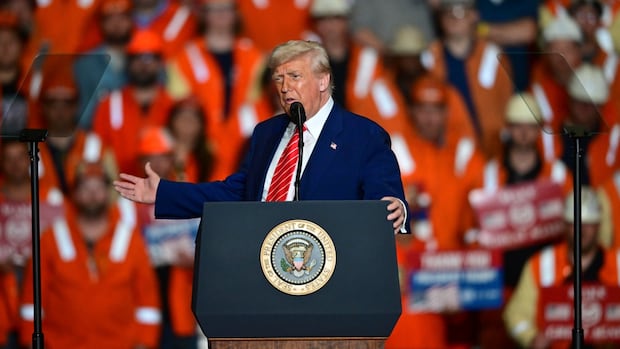U.S. President Donald Trump said he will double the tariffs on steel and aluminum imports to 50 per cent next Wednesday.
Trump initially announced the boosted duties on steel during a rally at U.S. Steel’s Mon Valley Works–Irvin Plant near Pittsburgh Friday evening. He told a cheering crowd of steelworkers that the increased levies will “further secure the steel industry in the United States.”
“Nobody is going to get around that,” Trump said.
In a post on social media after the rally, Trump said he would also be increasing tariffs on aluminum to 50 per cent.
“Our steel and aluminum industries are coming back like never before,” he wrote. “This will be yet another BIG jolt of great news for our wonderful steel and aluminum workers. MAKE AMERICA GREAT AGAIN!”
The prime minister’s office did not immediately comment.
The National’s At Issue breaks down how another week of back-and-forth on tariffs from the U.S. could change Canada’s negotiating position? Plus, the changing dynamics in the House under a new government.
The U.S. first imposed 25 per cent tariffs on steel and aluminum from Canada in March. Canada is the largest steel supplier to the United States, accounting for nearly 25 per cent of all imports in 2023. About a quarter of all steel used in America is imported.
Trump on Friday said he was thinking about a 40-per-cent tariff, but said “the group” wanted it to be 50 per cent.
As the duties have increased with Trump’s tariffs, the government’s producer price index found the price of steel products has gone up roughly 16 per cent.
Bea Bruske, president of the Canadian Labour Congress, said Trump’s plan to double steel and aluminum tariffs is “yet another direct attack on Canadian workers and a reckless move that will send shock waves across the Canadian economy.”
“This decision will shut us out of the U.S. market completely, devastating Canada’s steel and aluminum industry and threatening thousands of good-paying, unionized Canadian jobs,” Bruske said.
Bruske said that, in light of the escalating threat, Canada’s unions call for immediate government action to protect workers. That includes emergency reforms to employment insurance and wage subsidies.
“We need a government that is prepared to stand up for Canadian industries, invest in good union jobs, and protect our economic sovereignty in the face of growing international uncertainty,” Bruske said.
Candace Laing, president and CEO of the Canadian Chamber of Commerce, said in a statement that unwinding the “efficient, competitive and reliable” cross-border supply chains in steel and aluminum “comes at a great cost to both countries.”
Laing said that, in 2018 under the last round of steel and aluminum tariffs, there was significant net negative job loss in America.
“Doubling the steel and aluminum tariffs to 50 [per cent] is antithetical to North American economic security,” she said. “The fact remains that Canada is a reliable and secure trading partner that supplies materials that sustain American jobs.”
Economists have said tariffs on steel and aluminum during the first Trump administration were costly for American companies and consumers.

Trump used national security powers to impose a 25 per cent tariff on steel imports and a 10 per cent tariff on aluminum imports in March 2018.
Nearly a year later, the White House announced a deal had been reached to prevent “surges” in steel and aluminum supplies from Canada and Mexico, ending the trade dispute.
A report by the Washington-based Tax Foundation said during that time companies were forced to pay higher prices and the duties resulted in the loss of about 75,000 manufacturing jobs.
The Peterson Institute for International Economics found that each job saved in steel-producing industries came at a high cost to consumers — roughly $650,000 US per job.
The Canadian steel industry has warned the return of Trump’s tariffs would bring back the disruption and harm seen in 2018. There were also job losses and production pauses in Canada.

